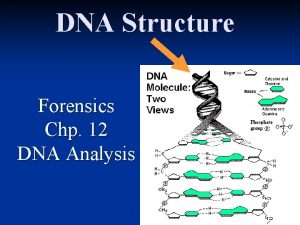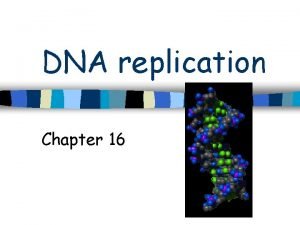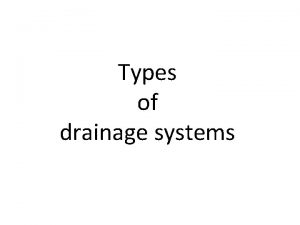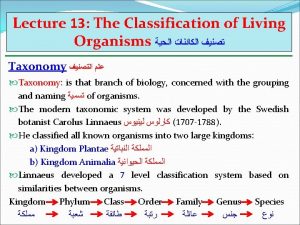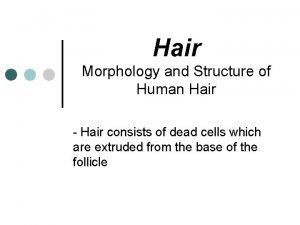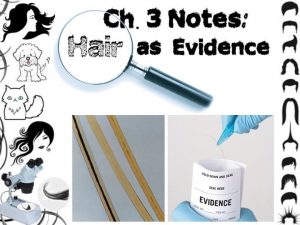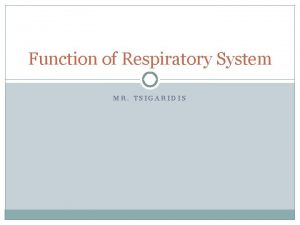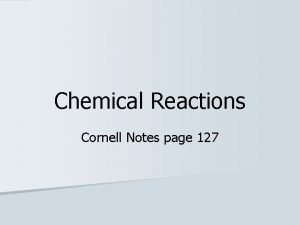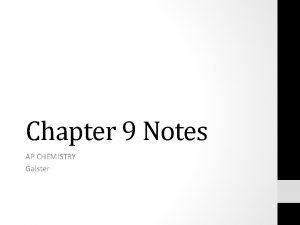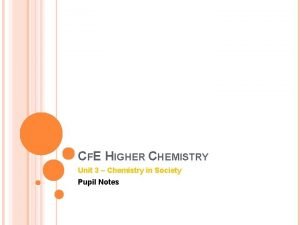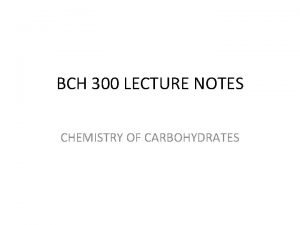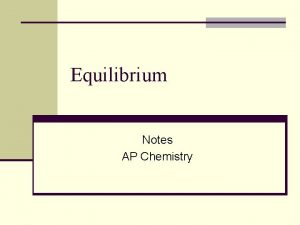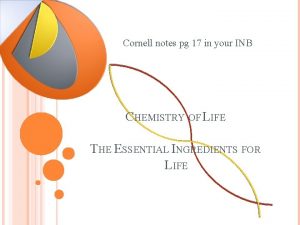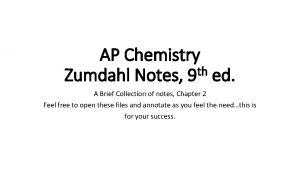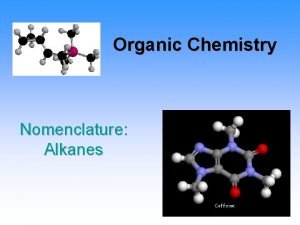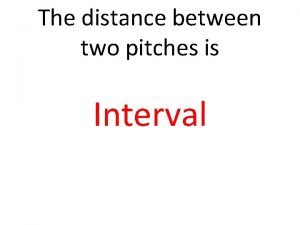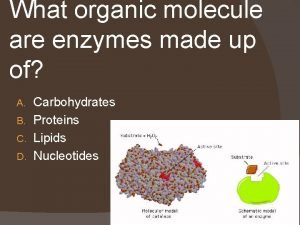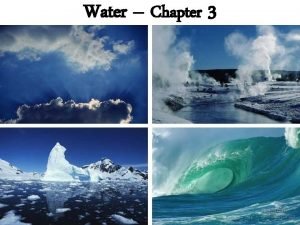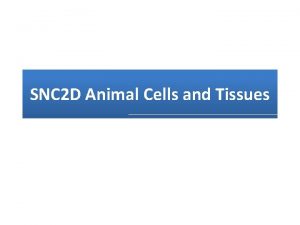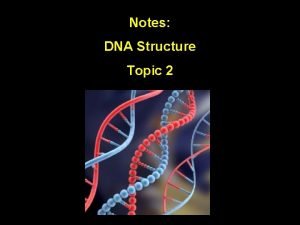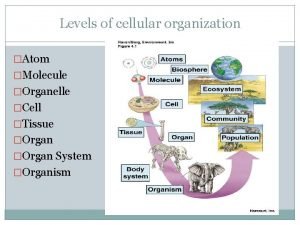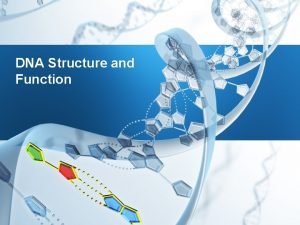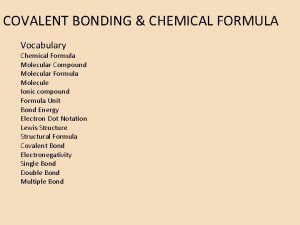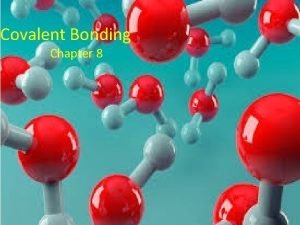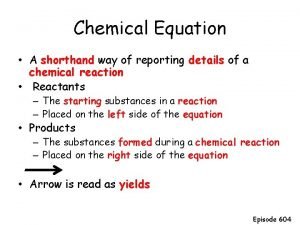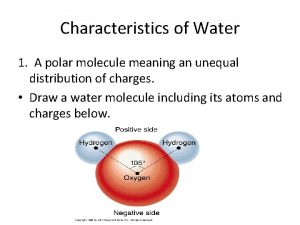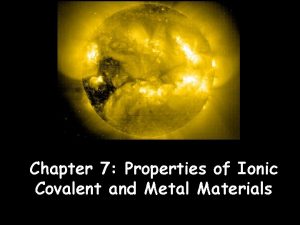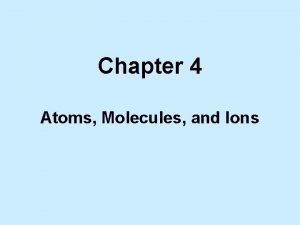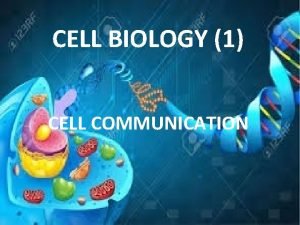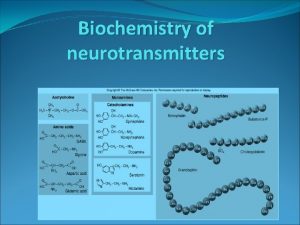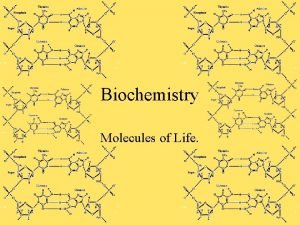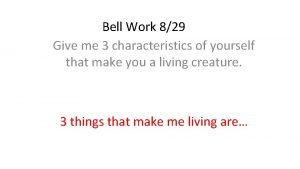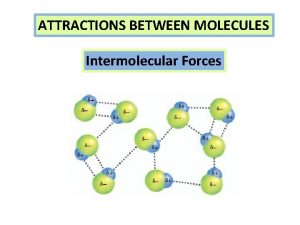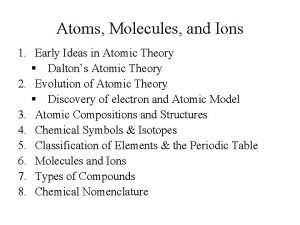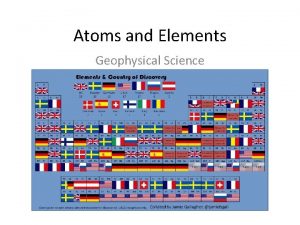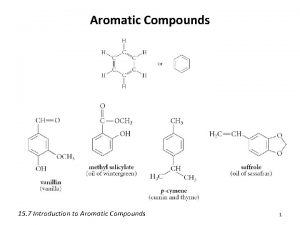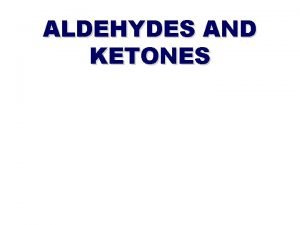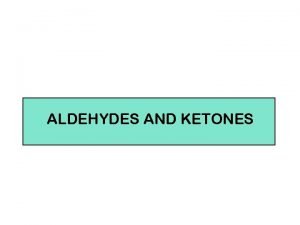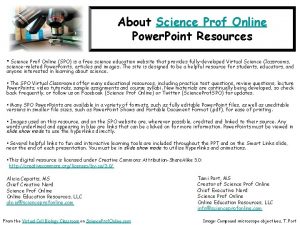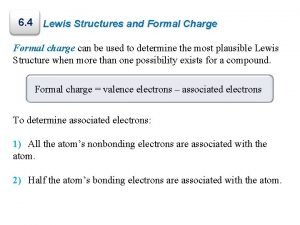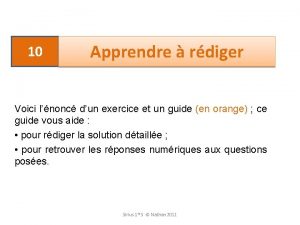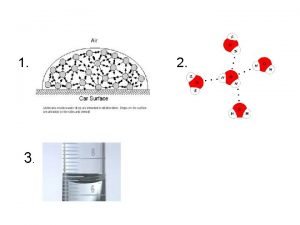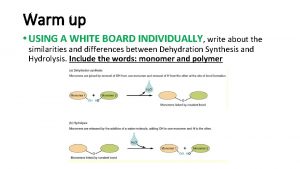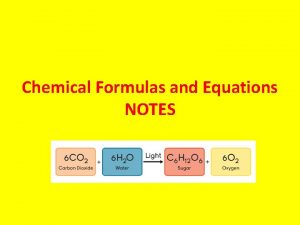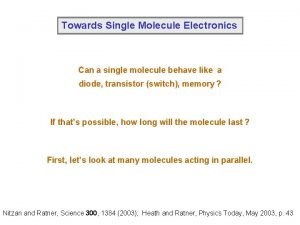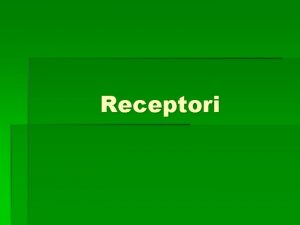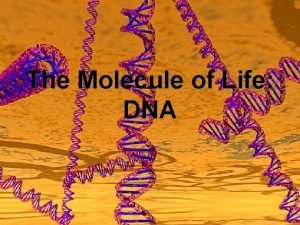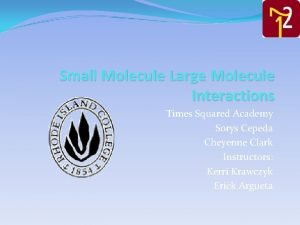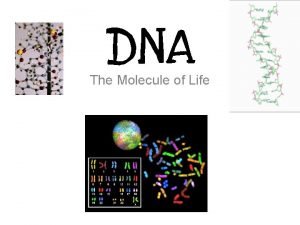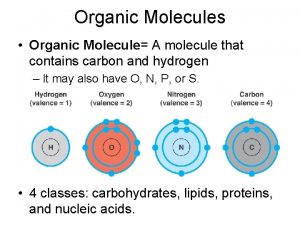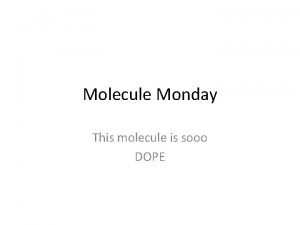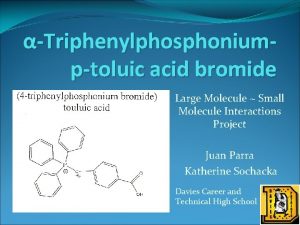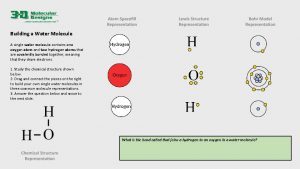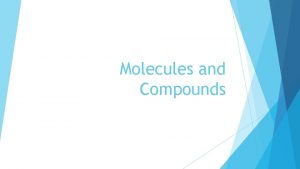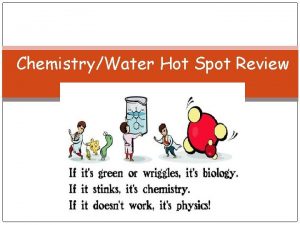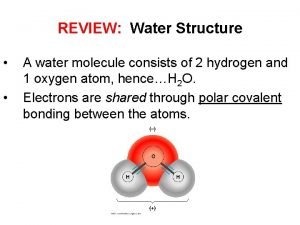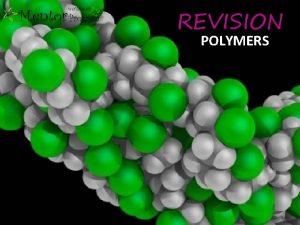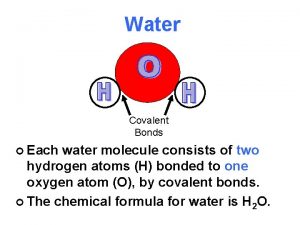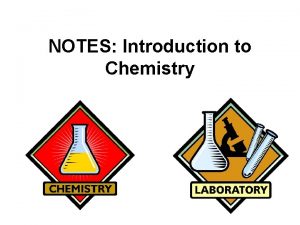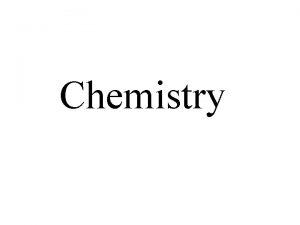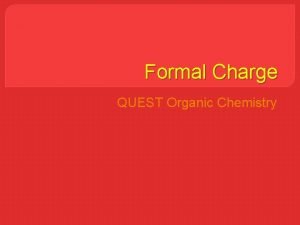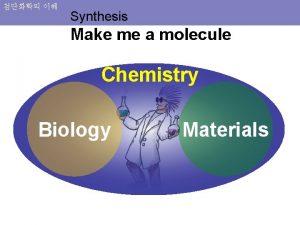Chemistry Notes A molecule consists of two or





















































- Slides: 53

Chemistry Notes

• A molecule consists of two or more atoms of the same element, or different elements, that are chemically bonded together. • The smallest part of a pure substance (element or compound) • Ex. One molecule H 20 vs. a glass of water.

• Diatomic molecule - composed of two of the same atom • Examples: H 2, N 2, O 2, Cl 2, Br 2 • In the animation above, two nitrogen atoms (N + N = N 2) make one Nitrogen molecule.

• Two or more different types of atoms chemically bonded to each other Table Salt & Ammonia are examples of compounds • Compounds have different properties than the elements it is made of. • All compounds are molecules, but not all molecules are compounds (diatomic molecules are NOT compounds)


• Organic Compounds- compounds containing covalently bonded carbon. • Example: C 6 H 12 O 6 (Glucose)

• The rule of 8. • Valence electrons are the electrons in the outermost energy level. • You must know the number of valence electrons an atom has. • When atoms chemically combine they try to end up with a full outermost energy level or 8 valence electrons by either gaining or losing electrons. • To meet this need: ▫ Metals tend to lose (give away) electrons. ▫ Nonmetals tend to gain electrons.

• Nature seeks balance! Having a full outermost energy level is stable. • That’s why the Noble Gases do not react. They already have a full outer level.

• The group (column) represents the number of valence electrons in the outer shell. • The period (row) represents the number of energy levels in the atom.

• A Lewis dot diagram is a system to represent atoms and their valence electrons.

• Drawing Lewis Dot Structures:

• An ionic bond is a bond that forms when valence electrons are lost or gained (transferred). It is the bond formed between oppositely charged ions. Example: • A lithium atom gives up an electron to a fluorine atom. • The result is a positively charged lithium ion and a negatively charged fluoride ion.

• Other ionic bond examples…….

• A metal bonded to a nonmetal (Groups 1 & 2 with Groups 6 & 7) • Conducts electricity when dissolved in water or melted. • High melting points. • Solids at room temperature.

A metallic bond is the attraction of free floating valence electrons. • Metal atoms can bond to atoms of the same element, or to other metals. • Electrons divide evenly among atoms- “electron sea”

A metallic compound is a metal bonded to another metal. • Metallic compounds have: • High melting points • Good conductors of heat and electricity • Malleable and ductile • Strong bonds • Atoms arranged in a pattern

• A covalent bond is a chemical bond formed when atoms share valence electrons. Usually nonmetals with nonmetals. • Elements that are close together on the periodic table are more likely to share electrons in a covalent bond than to transfer electrons. • Hydrogen, Carbon, Nitrogen, and Oxygen usually form covalent bonds.

• Drawing covalent bonds…. .

• Hydrogen has one unpaired electron. • Two hydrogen atoms share their single electrons to form a pair. • The shared pair of electrons is a single covalent bond, which holds the hydrogen molecule H 2 together.

Drawing single covalent bonds….

• Some atoms may form stronger bonds by sharing more than one pair of electrons. • A double bond has two pairs of shared electrons and is stronger than a single bond. • A triple bond has three pairs of shared electrons and is stronger than a double bond.

Drawing double & triple bonds….

• Drawing covalent bonds…. .

Hydrogen, Oxygen, Nitrogen, and Carbon make up 98% of all living things

• Every Hydrogen atom has 1 line connecting it to other atoms. • Every Oxygen atom has 2 lines connecting it to other atoms. • Every Nitrogen atom has 3 lines connecting it to other atoms. • Every Carbon atom has 4 lines connecting it to other atoms.

• Do not conduct electricity in water. • More flammable than ionic compounds. • Softer than ionic compounds. • Low melting and boiling points. • Usually do not dissolve in water (not soluble)

• Information about the atoms that make up a molecule/compound • Atoms will combine in specific rations due to the number of electrons shared or transferred. Example: • The chemical formula for sucrose, C 12 H 22 O 11, includes all the atoms in one molecule.

• Step 1: Determine the elements to be used in the formula and their oxidation numbers Mg +2 • Step 2 Solve by making the charge of one atom the subscript for the other. **If the subscript is 1, you do not need to write it. F -1 Mg +2 F -1 = Mg F 2

• Try it: • Sodium Chloride • Calcium Fluoride • Carbon Tetrachloride • Aluminum Oxide • Magnesium Oxide • Carbon Dioxide **If the subscript is 1, you do not need to write it.

• A polymer is a covalent compound made up of many repeating units linked together in a chain. Analogy = Beaded Necklace • A monomer is a single molecule that forms a link (beads) in a polymer chain (necklace).

• Examples of Polymers: • • • Carbohydrates Plastics Proteins DNA Rubber

• Acids are substances that release a positively charged hydrogen ion, H+, in water. The strength of the acid depends on the concentration of H+ ions. • Acids are also used in making many products, such as fertilizers, detergent, and cleaners. • Acids are important in several body processes, including breaking down food in the stomach. Acid Properties • Can neutralize a base • Sour • Turn blue litmus paper red • Feel like water • Conduct electricity • p. H between 1 -6 • React with metals

• Bases are substances that produce negatively charged hydroxide ions (OH-) when dissolved in water. • Common bases include baking soda and cleaning agents. Base Properties • Feel slippery • Dissolve fats, oils, and grease • Bitter taste • Neutralize acids to produce salt and water • Turn red litmus paper blue • Conduct electricity • Have a p. H between 8 -14 � Acids and Bases

• p. H is a numerical scale used to determine the strength or weakness of an acid or base. • The p. H scale runs from 0 to 14 – Acids are below 7; strong acids are near 0. – Bases are above 7; strong bases near 14. - Neutral solutions have a p. H of 7.

• p. H can be measured using different indicators: • • Litmus paper (red or blue) p. H paper (pool test strips) Universal indicator (cabbage juice) p. H meter


• A mixture is a combination of two or more substances that can be separated by physical means (i. e. filtering, evaporation, magnet, etc. ) • NO CHEMICAL BOND • Solutions are also mixtures. • Solutions are groups of molecules that are mixed up in a completely even distribution.

• Also called solution • Uniform appearance • Evenly mixed at the atomic level • Ex: blood, milk, metal alloy, air

• Also called solution • Uniform appearance • Evenly mixed at the atomic level • Ex: blood, milk, metal alloy, air • Not evenly mixed • Distinct substances • Ex: granite, mixed nuts, salad dressing

Physical properties can be observed without changing the substance. Ex: phase of matter, color, taste, odor, shape, texture, density, melting point, boiling point, hardness, conductivity, malleability


A chemical property is the ability or inability of a substance to combine with or change into one or more new substances (how a substance reacts with other substances). • Examples of chemical properties include burning or rusting. • Some substances do not react.


• Physical change: What the substance is made of does not change. Physical changes are reversible. • Ex) Changing from one state to another Other Examples: Cutting a lawn, breaking glass, Melting ice

Chemical change: Change one substance into a new substance. • Chemical bonds are formed/rearranged • New substances have different properties and compositions than the original substances. • Usually chemical changes cannot be easily reversed. Property Changes

• If a substance reacts with another substance, it means there is an attraction between atoms. A Chemical Bond formed! Not easily separated. Evidence that a chemical change (reaction) has occurred • Heat produced/absorbed • Gas produced (bubbles/fizzing) • Odor produced • Electricity produced • Light produced • Precipitate produced (solid/solute coming out of solution) • Color change (weakest evidence!)

• Chemical equations show that in chemical reactions, atoms rearrange, but no atoms are gained or lost.

• Reactants are the original substances in a chemical reaction and are placed on the left side. • Products are the new substances in a chemical reaction and are placed on the right side. reactant + reactant original substances product new substance/s

• A subscript tells how many atoms of an element are in one molecule. • A coefficient tells how many atoms, molecules, or formula units are in a reaction.

Na. HCO 3 + CH 3 COOH CO 2 + H 2 O + Na. C 2 H 3 O 2

Balanced All chemical reactions must obey the Law of Conservation of Matter # of atoms on the left = # of atoms on the right

Step 1 Determine the correct symbols and formulas for reactants and products. Step 2 Write reactant symbols and formulas to the left of an arrow and product symbols and formulas to the right. Step 3 Count the number of each kind of atom on both sides. Step 4 Use coefficients to make the number of each kind of atom the same on both sides of the arrow. Step 5 Check to see that each kind of atom balances.

Reaction of methane: CH 4 + O 2 → CO 2 + H 2 O
 Dna molecule two views
Dna molecule two views Phosphodiester bond
Phosphodiester bond Two pipe system of providing building drainage consists of
Two pipe system of providing building drainage consists of Order of classification of organisms
Order of classification of organisms Hair consists of two parts
Hair consists of two parts Middle layer and largest part of the hair shaft in humans
Middle layer and largest part of the hair shaft in humans Pulmonary ventilation consists of two cyclic phases, , and
Pulmonary ventilation consists of two cyclic phases, , and Ib chemistry organic chemistry
Ib chemistry organic chemistry Inorganic vs organic chemistry
Inorganic vs organic chemistry Cornell notes chemistry
Cornell notes chemistry Ap chemistry unit 9 notes
Ap chemistry unit 9 notes Cfe higher chemistry
Cfe higher chemistry Epimers of carbohydrates
Epimers of carbohydrates Advanced inorganic chemistry lecture notes
Advanced inorganic chemistry lecture notes Ap chemistry equilibrium notes
Ap chemistry equilibrium notes Cornell notes for chemistry
Cornell notes for chemistry Zumdahl chemistry, 9th edition notes
Zumdahl chemistry, 9th edition notes Organic chemistry class 11 notes
Organic chemistry class 11 notes An introduction to atmospheric physics
An introduction to atmospheric physics Wisc
Wisc The distance between two pitches.
The distance between two pitches. Enzymes are composed of what organic molecule
Enzymes are composed of what organic molecule Are water molecules polar
Are water molecules polar What is the mole formula
What is the mole formula Atoms
Atoms Nucleic acid diagram labeled
Nucleic acid diagram labeled Nh bond polarity
Nh bond polarity Organelle organization
Organelle organization Atomicity table
Atomicity table Water molecule evaporation
Water molecule evaporation What is the function of dna
What is the function of dna Difference between molecular and covalent
Difference between molecular and covalent Chapter 8 covalent bonding
Chapter 8 covalent bonding A chemist shorthand way of presenting chemical reaction
A chemist shorthand way of presenting chemical reaction Polar molecule meaning
Polar molecule meaning Why are molecular compounds poor conductors
Why are molecular compounds poor conductors Atom molecule and ion
Atom molecule and ion Ligand signaling molecule
Ligand signaling molecule Row materials
Row materials Small molecule neurotransmitters
Small molecule neurotransmitters Carbohydrate organic compound
Carbohydrate organic compound Cell tissue
Cell tissue Intermolecular forces and boiling point
Intermolecular forces and boiling point Atom molecule and ion
Atom molecule and ion Expanded octet
Expanded octet Classify the following molecule
Classify the following molecule Aldehyde ending
Aldehyde ending Ketone molecule
Ketone molecule Oil rig biology
Oil rig biology How to calculate formal charge?
How to calculate formal charge? Schéma de lewis molécule de caféine
Schéma de lewis molécule de caféine Hydrophilic molecules
Hydrophilic molecules What holds molecules together
What holds molecules together Nitrogen-containing base
Nitrogen-containing base
